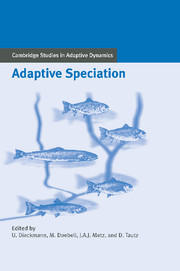Book contents
- Frontmatter
- Contents
- Contributing Authors
- Acknowledgments
- Notational Standards
- 1 Introduction
- 2 Speciation in Historical Perspective
- A Theories of Speciation
- B Ecological Mechanisms of Speciation
- C Patterns of Speciation
- 15 Phylogeography and Patterns of Incipient Speciation
- 16 Evolutionary Diversification of Caribbean Anolis Lizards
- 17 Adaptive Radiation of African Montane Plants
- 18 Diversity and Speciation of Semionotid Fishes in Mesozoic Rift Lakes
- 19 Epilogue
- References
- Index
19 - Epilogue
Published online by Cambridge University Press: 05 July 2014
- Frontmatter
- Contents
- Contributing Authors
- Acknowledgments
- Notational Standards
- 1 Introduction
- 2 Speciation in Historical Perspective
- A Theories of Speciation
- B Ecological Mechanisms of Speciation
- C Patterns of Speciation
- 15 Phylogeography and Patterns of Incipient Speciation
- 16 Evolutionary Diversification of Caribbean Anolis Lizards
- 17 Adaptive Radiation of African Montane Plants
- 18 Diversity and Speciation of Semionotid Fishes in Mesozoic Rift Lakes
- 19 Epilogue
- References
- Index
Summary
When Terry Erwin from the Smithsonian National Museum of Natural History examined the diversity of beetles that lived on a single species of tropical trees, he found 682 different beetle species, 163 of which he classified as specialist species that lived exclusively on the particular tree species used in his study. Since there are around 50000 tropical trees species, Erwin extrapolated that there must be on the order of 7 million specialist beetle species (Erwin 1982). Using similar extrapolations, Erwin (1982) also estimated the total number of tropical arthropod species as about 30000000. While these estimates may be too high (Schilthuizen 2000; Ødegaard 2000; Novotny et al. 2002), they are mind-boggling nevertheless and serve as an illustration of the incredible amount of species diversity that exists on our planet: estimates for the total number of extant species of plants and animals range from 10 million to 100 million (May 1990; Schilthuizen 2000). It is also estimated that the number of extant species represents only about 1% of the total number of species that ever existed during the history of life on earth. Together with the common phylogenetic ancestry usually inferred for the tree of life for higher organisms, this implies that speciation must have been truly rampant during the creation and evolution of our biosphere.
- Type
- Chapter
- Information
- Adaptive Speciation , pp. 380 - 394Publisher: Cambridge University PressPrint publication year: 2004
- 6
- Cited by



